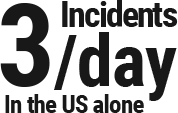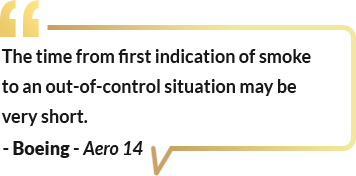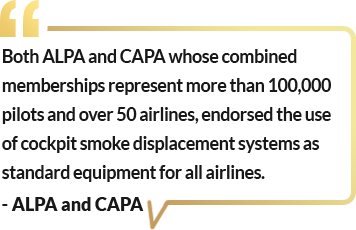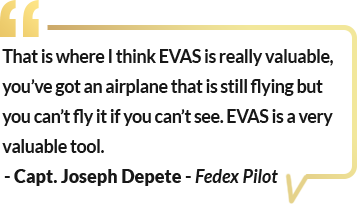


The ability for a pilot to see in order to fly the aircraft is one of the most crucial facets of safe flight. Cargo Operators the world over know the dangers involved with blinding smoke in the cockpit, which has led to over 69% of the worlds air cargo operators becoming EVAS equipped.
This includes a 747 cargo aircraft which became engulfed by smoke originating from a lithium battery fire in its cargo hold. The pilot was unable to even see the dial on the radio to get the right frequency and heading. Despite the aircraft being flyable, the pilot missed the opportunity to land the aircraft and overshot the airport and came within several hundred yards of hitting civilian apartments. Since then the operator of that aircraft equipped its entire fleet with EVAS, shortly thereafter its competitor did the same, followed by many other cargo operators.
After numerous incidences of smoke impeding pilots vision, and with catastrophic loss as a result, VisionSafe corporation came up with the solution. EVAS is the worlds only smoke displacement system, which allows a pilot to see their controls even in a smoke filled aircraft.

Due to smoke or fumes on aircraft.

69% of worldwide part 121 air freighters have been equipped with EVAS.

Over 8000 EVAS systems have been installed worldwide.
Both the Air Line Pilots Association (ALPA) and the Coalition of Air Line Pilots Association (CAPA) whose combined memberships represent more than 100,000 pilots and over 50 airlines, endorsed the use of cockpit smoke displacement systems (CSDS) as "standard" equipment for all airlines.
“Oil from the APU (Auxiliary Power Unit) was leaking into the air conditioning hot-air ducts, which resulted in a great deal of smoke in the cockpit. The smoke began coming in through the air vents and filling the cabin and cockpit to the point where I couldn’t see anything, including the flight instruments. At nighttime with an overhead light turned on, it created a beam of light which did nothing more than illuminate the smoke in the cockpit. This is like turning your high beams on and driving in fog. You can’t see anything, except what’s close to you. We donned our smoke goggles which protected our eyes against the smoke, but we still were unable to see anything. I had to lean so far forward in an attempt to see the flight instruments that I was pushing on the yoke. I was leaning in such a very awkward position simply to see the flight instruments..”
“Another emergency I had was a burning air conditioning recirculation fan. It was burning up and shorting out, and the fumes were so noxious they were burning our eyes, and our throats. We needed to shut down all our electric equipment to try to figure out what was causing this, so we shut everything off, including our weather radar, which we were using to circumnavigate thunderstorms. That was a bit hair raising.”
“The cockpit filled with smoke, it wasn’t insidious, it happened all of a sudden, real quickly, and we didn’t know what caused that one, but we had the same issue--I couldn’t see my flight instruments. I had to put on my mask and goggles, and the oxygen mask hose caught on something. I couldn’t lean forward, and couldn’t figure out what it was caught on. I couldn’t see anything anyway, so here I am trying to get closer to my flight instruments, and I couldn’t. I couldn’t see the panel, so I’m feeling around the cockpit by hand where the auto pilot controls are, Until we get this smoke issue resolved, we can’t see anything in the cockpit or what to do.”




Capt. Depete - Pilot, FedEx - VP of ALPA shares EVAS experience
An overview of the Emergency Vision Assurance System
